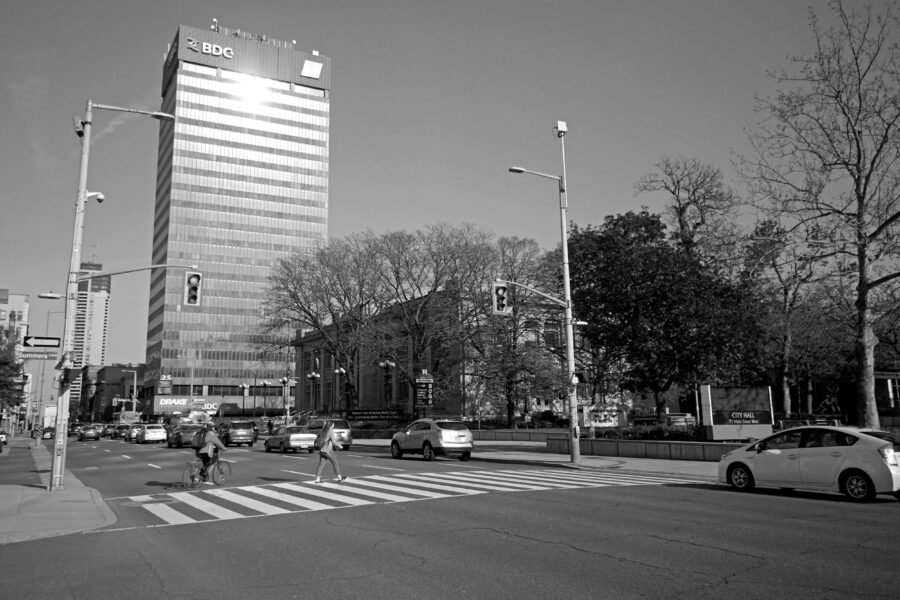
Traffic Troubles
- Marty Edwards
- 02 Jun 2017
Is Hamilton’s aging system causing speeding?
By Marty Edwards
Traffic. It’s a contentious subject in Hamilton and complaining about it is certainly on-trend right now. Most Hamiltonians of a certain age know that, in the past, the Main Street East intersections were progressively synchronized to keep the flow of traffic moving at 50 kph. Some may even recall that the City used to have signs posted indicating exactly this. Essentially, drivers were rewarded for driving at relatively slow speeds.
But speeding has increased along Main Street East over the years. Frustrated drivers accustomed to the synchronization of the lights are driving faster to avoid getting caught at a red. Many have complained that the Main Street East traffic signals have become unsynchronized, with some even claiming they’ve been re-synced to a higher 60 kph. The reckless and selfish drivers racing through our downtown may give the impression that the latter is true, but the truth is much more ordinary; our aging traffic signals’ internal clocks are wearing out.
Traffic congestion is a typical sign of an improved economy. That is an undeniably great thing that has happened to our downtown during the past few years. But sitting repeatedly at red lights increases pollution as well as driver stress and tension. This generally leads to an unhappier population. Just ask London, England, the city with the worst traffic congestion in the world according to INRIX’s 2015 Traffic Scorecard. With institutions like McMaster drawing hoards to the core again, Hamilton’s current condition is the result of more people crowding into the exact area with failing traffic signal clocks.
David Ferguson, Superintendent of Traffic Engineering for the City of Hamilton, says the Main Street East lights are still currently synced to 50 kph. The problem lies in the controller boxes that operate each set of lights. “The City of Hamilton system is old,” states Ferguson. “The oldest clocks are up to 15 years old.” Hamilton is a long and narrow city, and while some people live within it, others need to get through it. With the City’s mandate to move traffic as safely and efficiently as possible, those old clocks need to go.
Traffic department activities today include upgrading the city-wide traffic management system and re-setting clocks that go out of sync with the rest in the traffic corridor. Clock reset duty falls to the staff, who must travel to each location in order to physically change the clocks, a time-consuming venture. When the system upgrades are in place, Ferguson says the new technology will allow staff to monitor traffic and change signals remotely in cases of accidents. Some of this technology is already in use in other parts of the city, but it’s not wide-spread.
The new technology is being installed under a five year plan. Intersections will receive traffic cameras and radios which the staff can use to monitor vehicular flow. The new system will also be able to send alerts to staff at the Traffic Management Centre, notifying them of locations that may need their attention. Staff can then decide to extend a green light for a few seconds to allow the back-log of travellers to clear the overburdened streets.
The new system won’t solve all our problems. As a tool, it will help control congestion and speeding, but there is still a need for alternatives. Ferguson agrees there needs to be a balance between cars and alternate forms of travel, such as bicycles. But, he points out, eliminating a lane of traffic does affect congestion elsewhere. There’s a domino effect to every change the city makes, and it can be challenging to get people to alter their behaviour.
When the controller box upgrades are complete, Main Street East will remain synchronized to 50 kph, which will alleviate some of the speeding problems the downtown area is currently seeing. Asked if they had considered timing the lights to 40 kph, Ferguson said there is no plan to change the timing of the lights, and his department has received no direction from city council to do that.
Moving the city safely and efficiently is the priority, and keeping vehicles moving reduces pollution and stress on citizens. Hamilton is headed in the right direction. We need to continue to find ways to overcome the difficulties inherent in incorporating alternative modes of transportation.
Ferguson’s department is currently looking at ways to improve safety for all road users as part of the City of Hamilton Strategic Road Safety Program. From 9,586 in 1988 to 3,673 in 2010, vehicular collisions in Hamilton have decreased 62%, which is a strong indicator that the city is on the right track.
Comments 0
There are no comments


Add comment